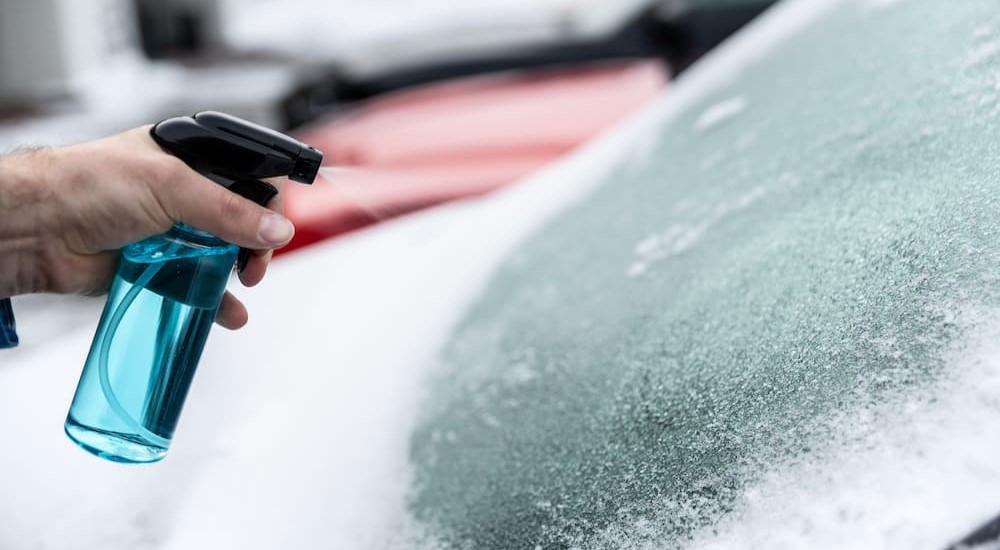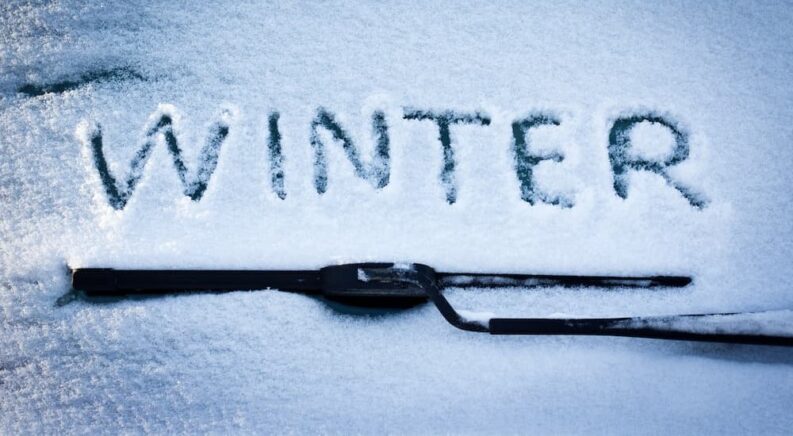The winter season can bring all sorts of challenges for drivers. From slick streets and road salt to rough starts and towering snow banks that obscure your vision, winter driving is no picnic behind the wheel. Some of these issues can start to rear their head before you even leave your driveway, especially when it comes to defrosting your vehicle and clearing it of snow. If you’re lucky enough to be driving a late-model car, truck, or SUV, you might be able to employ a remote start feature that gets your vehicle nice and toasty while you’re still inside sipping your coffee. For the rest of us, the specter of snow and ice removal can make an already difficult morning all the more challenging.
Luckily, Check Engine is here to help. Based in New Hampshire, we’re no stranger to some tough winter weather and have learned a thing or two over the years of dealing with Nor’easters, snow days, and pesky plow trucks. We’ll get into some of our best defrosting methods, as well as address some general ice and snow removal tips. Old Man Winter might be a harsh taskmaster, but a little preparation goes a long way when dealing with a snow-covered vehicle.
Defrosting
As soon as you’ve cleared any snow from around your tailpipe, it’s time to start your engine and let your vehicle’s defroster do its thing. Running your front and rear defroster for 10 to 15 minutes will allow a thin layer of snow or ice to melt. It can also be helpful when it comes to dealing with a thicker coating, at least beginning to dislodge it from the glass so it’s easier to remove.
While the defroster works its magic, you can multitask by shoveling snow from around the vehicle. Almost every vehicle comes with front and rear defrosters that are specifically designed to target the windshields. If yours doesn’t, or the system is on the fritz, running heat through the other vents and pointing them at the windows as best you can should allow the vehicle to warm up enough to make any snow or ice removal a lot easier.
Start at the Top
Our second tip might fall under the category of common sense, but refreshing yourself on the basics never hurts. When clearing snow or ice from your car, make the job a little easier by starting from the top and working your way down. This method allows you to avoid shoveling the same snow twice, making all the difference when rushing off to work or trying to free your car before the plow truck comes around to take another pass at the street and re-buries it.
Don’t Forget the Roof
While we all might be nostalgic for the cozy snow days of our youth, adulthood makes fewer concessions towards the weather. If your morning commute starts with 20 to 30 minutes of shoveling, it can be tempting to take some shortcuts, but this is rarely a good idea. Failing to clean snow from the entirety of your vehicle, especially the roof, is a recipe for disaster as that high-riding snowbank always seems to come crashing down at the worst time. As the vehicle warms up, the snow of your vehicle’s roof will start to melt, which can cause the snow to fly off the roof when you accelerate or cascade down your windshield the next time you come to a stop. Always take the time to clear the snow from your roof before taking your vehicle out on the road. It’s not only a good idea, it’s legally required in many states, which we’ll get into in just a bit.
After clearing the roof, windows and hood, make sure to address the side mirrors, headlights, taillights and turn signals. These are all essential pieces of safety-enhancing equipment, especially when the snow is still falling and visibility is low.
The Right Tools for the Job
Start preparing for snow and ice removal before the first flakes fly by investing in a quality snow brush and ice scraper. Plenty of products are on the market, and many are designed with a two-in-one approach that sees a brush placed on one end and a snow scraper on the other. Telescoping models allow drivers to access hard-to-reach areas, like the top of a hulking pickup, and can make a big difference in speeding up the task. If you live in a region where snow isn’t common, you might be tempted to make do with a shovel or some other metal tool. These ad-hoc ice scrapers can easily damage the paint or glass, leaving your vehicle criss-crossed in unsightly scratches, chips, or even a cracked windshield.
A de-icing solution can also come in handy, but if you’re not willing to part with the $5 to $10 they might cost, there are a couple of DIY alternatives. Creating your own de-icer is as easy as mixing two parts 70 percent isopropyl alcohol with one part water and a dash of dishwashing liquid. Alternatively, replace the alcohol with three parts vinegar. Keep in mind that overusing either solution can cause damage to the protective layer that shields the paint. Some drivers will pre-apply this de-icing solution the night before a storm, but it also works afterward.
Wipers Up (Or Down?)
When expecting snowy conditions, many drivers raise their windshield wipers up and away from the glass in preparation. Having the wipers in an upright position can make it easier to quickly clear ice and snow from the windshield the next day, and also carries some advantages when it comes to general wear and tear. If the wipers are pressed against the glass, snow and ice can freeze them into position and create some headaches. Drivers not only risk damaging the wiper blades when attempting to unstick them, but being frozen in place can also strain the wiper’s motor and linkage if you accidentally activate the wipers.
Not every driver agrees with this approach and will leave their wipers down during a winter storm. The two methods are comparable as long as you’re not in a hurry and give the defroster time to work its magic. However, leaving your wipers up could help to speed up the process if you expect to be short on time.
Once the windshield is clean and the wipers are moving freely, ensure they can move in their full range of motion. Snow tends to get packed in the area where the windshield and hood meet, as well as the driver’s side of the windshield, which can prevent the wipers from reaching the top and bottom points of their arc. Such obstructions can cause damage to the motor, linkage, or wiper itself and will usually be accompanied by a louder-than-normal “thump.” Also, take a moment to ensure the windshield washer nozzles are clear of any ice or snow. That’s not the sort of information you want to suddenly discover while cruising at highway speeds.

Water It
They say you must fight fire with fire, but fighting frozen water with water works just as well. If you want to speed up defrosting, a little lukewarm water can go a long way. This is especially helpful regarding sticky door handles or iced-over keyholes. Beware that using water that’s too hot can easily negate the convenience and leave you with a big-ticket repair. Pouring a kettle of hot water on the windshield might seem like a good idea, but the sudden shift from cold to warm can cause cracks and even full-on shattering. Stick with lukewarm water, generally between 95 and 105 degrees, and clean up any excess liquid that might run off the vehicle and freeze on the ground that might create a slipping hazard.
Consequences
Saving a little time on a frigid morning isn’t worth the risk. Drivers who have their vision obscured by a snowy or icy windshield not only risk their own safety and that of every other vehicle on the road but could also wind up with a hefty fine if police take notice of the porthole approach. Many states have specific laws that require drivers to thoroughly remove snow and ice from their windshields, but even in states without such a rule, police can still easily issue a ticket for unsafe driving.
Take New York, for example. While the Empire State has never passed a law specifically addressing snow removal, existing rules bar any driver from operating a vehicle with an obstructed view or snow-covered license plate. Other states like Wisconsin are more specific, requiring drivers to make a reasonable effort to clear their vehicle of ice and snow or face a fine of up to $175. Pennsylvania is even stricter, with a law stating that all vehicles must be cleared of ice and snow within 24 hours of a storm. The fine is relatively modest at $50, but if any of that snow and ice flies off while driving and causes an injury, you could end up with a ticket as high as $1,500. Before setting off on your next mid-winter journey, take a moment to read up on your local laws and see how these rules might be applied in your state.
If you’re still not convinced, allow us to put a face on the potential consequences. New Hampshire’s snow removal law, known as Jessica’s Law, is one of the country’s most stringent, with fines ranging from $250 to $500 for a first offense and $500 to $1,000 for the second, and even a 30-day loss of license. The strict rule was inspired by the death of Jessica Smith, a New Hampshire resident who lost her life in 1999 when a snow falling from a passing truck caused a head-on collision. New Hampshire passed Jessica’s Law four years later, largely thanks to the lobbying efforts of Jessica’s mother, Linda Smith. “It takes not even five minutes to clean off your car,” said Smith. “It can take three seconds to kill somebody.”
Thoroughly cleaning your vehicle or ice and snow can make all the difference when it comes to comfortably and safely operating your vehicle in the winter months. No one likes shoveling snow or scraping ice, but rushing the process is a surefire way to endanger yourself and others. If this whole routine sounds a little daunting, there are a few ways to simplify the process. As we said, many of today’s vehicles have a remote start feature that allows drivers to kick-start the defrosting process without stepping outside. Aftermarket remote starters are also an option. Typically retailing for $200 to $500, including installation, these kits can be helpful when dealing with an older vehicle or a new model that didn’t come with all the bells and whistles. No matter what approach you decide to take, just remember that a little elbow grease (and some cold fingers) can go a long way when creating a safer road.

